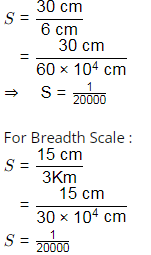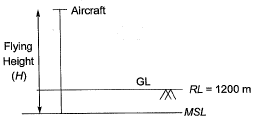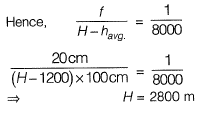Past Year Questions: Time Concept, Remote Sensing, GIS, GPS & Photogrammetry | Topic wise GATE Past Year Papers for Civil Engineering - Civil Engineering (CE) PDF Download
Q1: For a reconnaissance survey, it is necessary to obtain vertical aerial photographs of a terrain at an average scale of 1:13000 using a camera. If the permissible flying height is assumed as 3000m above a datum and the average terrain elevation is 1050 m above the datum, the required focal length (in mm) of the camera is [2024, Set-ll]
(a)100
(b) 150
(c) 125
(d) 200
Ans: (b)
Q2: A bird is resting on a point P at a height of 8 m above the Mean Sea Level (MSL). Upon hearing a loud noise, the bird flies parallel to the ground surface and reaches a point Q which is located at a height of 3 m above MSL. The ground surface has a falling gradient of 1 in 2. Ignoring the effects of curvature and refraction, the horizontal distance (in meters) between points P and Q is ____ (in integer). [2024, Set-l]
Ans: 10 to 10

For a falling gradient of 1 in 2 ,
∴ For vertical distance of 5 m 5 m between P and Q,
Horizontal distance between P and Q
= 5 × 2
= 10 m
Q3: If the size of the ground area is 6 km × 3 km and the corresponding photo size in the aerial photograph is 30 cm × 15 cm, then the scale of the photograph is 1 : ____ (in integer). [2023, Set-ll]
Ans: 20000 to 20000

For Length scale:

∴ Scale of photograph, S = 1 : 20000
Q4: An aerial photograph is taken from a flight at a height of 3.5 km above mean sea level, using a camera of focal length 152 mm. If the average ground elevation is 460 m above mean sea level, then the scale of the photograph is [2022, Set-l]
(a) 1 : 20000
(b) 01:20
(c) 1 : 100000
(d) 1.986111111
Ans: (a)
H = 35. Km = 3500m
f = 152mm
havg = 460m


Q5: A camera with a focal length of 20 cm fitted in an aircraft is used for taking vertical aerial photographs of a terrain. The average elevation of the terrain is 1200 m above mean sea level (MSL). What is the height above MSL at which an aircraft must fly in order to get the aerial photographs at a scale of 1:8000? [2019 : 2 Marks, Set-ll]
(a) 3200 m
(b) 2600 m
(c) 3000 m
(d) 2800 m
Ans: (d)

Given focal length = 20 cm
as we know scale of vertical photograph

its given as 1 : 8000

Q6: An aerial photograph of a terrain having an average elevation of 1400 m is taken at a scale of 1:7500. The focal length of the camera is 15 cm. The altitude of the flight above mean sea level (in m, up to one decimal place) is _________. [2018 : 2 Marks, Set-II]
Ans: h= 1400 m
Scale = 1 : 7500
f = 15 cm


Q7: A square area (on the surface of the earth) with side 100 m and uniform height, appears as 1 cm2 on a vertical aerial photograph. The topographic map shows that a contour of 650 m passes through the area. If focal length of the camera lens is 150 mm, the height from which the aerial photograph was taken, is [2018 : 2 Marks, Set-I]
(a) 800 m
(b) 1500 m
(c) 2150 m
(d) 3150 m
Ans: (c)
A =100 x 100 m2
Area on photo, a = 1 cm2
Scale 1 cm =100
f = 150 mm
h = 650 m
Scale 


Q8: Two towers, A and B, standing vertically on a horizontal ground, appear in a vertical aerial photograph as shown in the figure. The length of the image of the tower A on the photograph is 1.5 cm and of the tower B is 2.0 cm. The distance of the top of the tower A (as shown by the arrowhead) is 4.0 cm and the distance of the top of the tower B is 6.0 cm, as measured from the principal point p of the photograph. If the height of the tower B is 80 m, the height (in meters) of the tower A is _____. [2017 : 2 Marks, Set-II]
The length of the image of the tower A on the photograph is 1.5 cm and of the tower B is 2.0 cm. The distance of the top of the tower A (as shown by the arrowhead) is 4.0 cm and the distance of the top of the tower B is 6.0 cm, as measured from the principal point p of the photograph. If the height of the tower B is 80 m, the height (in meters) of the tower A is _____. [2017 : 2 Marks, Set-II]
Ans: For Tower A:
Relief displacement,
dA = 1.5 cm
rA = 4 cm, hA = ?For Tower B:
Relief displacement,
dB = 2.0 cm, rB = 6 cm, hB = 80 m
Relief displacement

Q9: The number of spectral bands in the Enhanced Thematic Mapper sensor on the remote sensing satellite Landsat-7 is [2017 : 1 Mark, Set-I]
(a) 64
(b) 10
(c) 8
(d) 15
Ans: (c)
Total number of spectrum band in Enhanced
Thematic Mapper sensor = 8
Band 1 - Blue
Band 2 - Green
Band 3 - Red
Band 4 - Near Infrared (NR)
Band 5 - Shortwave Infrared (SWIR)
Band 6 - Thermal
Band 7 - Shortwave Infrared (SWIR)
Band 8 - Panchromatic
Q10: A tall tower was photographed from an elevation of 700 m above the datum. The radial distances of the top and bottom of the tower from the principal points are 112.50 mm and 82.40 mm, respectively. If the bottom of the tower is at an elevation 250 m above the datum, then the height (expressed in m) of the tower is _____ [2016 : 2 Marks, Set-II]
Ans: Given: H = 700 m, havg = 250
Given: H = 700 m, havg = 250
Relief distance,
d = q - r
= 112.5 - 82.40
= 30.1 mm
∴ 
[where h is height of tower]
⇒ 
∴ h = 120.4 mm
Q11: Optimal flight planning for a photogrammetric survey should be carried out considering [2016 : 1 Mark, Set-II]
(a) only side-lap
(b) only end-lap
(c) either side-lap or end-lap
(d) both side-lap as well as end-lap
Ans: (d)
Q12: The system that uses the Sun as a source of electromagnetic energy and records the naturally radiated and reflected energy from the object is called [2016 : 1 Mark, Set-I]
(a) Geographical Information System
(b) Global Positioning System
(c) Passive Remote Sensing
(d) Active Remote Sensing
Ans: (c)
The sun provide a very convenient source of energy for remote sensing. The Sun’s energy is either reflected, as it is for visible wavelengths, or absorbed and then re-emitted, as it is for thermal infrared wavelengths. Remote sensing system which measure energy i.e., naturally available are called as passive remote sensing.
Q13: The minimum number of satellites needed for a GPS to determine its position precisely is [2016 : 1 Mark, Set-I]
(a) 2
(b) 3
(c) 4
(d) 24
Ans: (c)
At a minimum, four satellite must be in view of the receiver for it to compute four unknown quantity (three position coordinate and one for clock deviation from satellite time).
Q14: The local mean time at a place located in Longitude 90° 40'E when the standard time is 6 hours and 30 minutes and the standard meridian is 82° 30' E is [2010 : 1 Mark]
(a) 5 hours, 2 minutes and 40 seconds
(b) 5 hours, 47 minutes and 20 seconds
(c) 6 hours and 30 minutes
(d) 7 hours, 02 minutes and 40 seconds
Ans: (d)
Difference between standard meridian and the longitude of the given place
= 90° 40'E - 82°30'E = 8°10'
The longitude of the given place is more than the standard meridian. Hence the local mean time of the given place will be ahead of the standard time.
= 0 hours and 32 minutes and 0 seconds
= 0 hours and 0 minutes and 40 seconds
Time for a difference of 8°10' = 32 minutes and 40 seconds
Local mean time = standard time + 32 minutes and 40 seconds
= 6 hours and 30 minutes + 32 minutes and 40 seconds
= 7 hours 02 minutes and 40 seconds
FAQs on Past Year Questions: Time Concept, Remote Sensing, GIS, GPS & Photogrammetry - Topic wise GATE Past Year Papers for Civil Engineering - Civil Engineering (CE)
| 1. What is the difference between Remote Sensing and GIS? |  |
| 2. How does GPS work and what are its main applications? |  |
| 3. What are the key principles of Photogrammetry? |  |
| 4. How can Time Concept be applied in GIS analysis? |  |
| 5. What are the advantages of using Remote Sensing in environmental monitoring? |  |
















